
in.charybdis, Generative Strands
148W 38N, North Pacific, Spring 2012
Instructor: Cecil Balmond & Ezio Blasetti
Team: Nam Il Joe, Laura Lo, Mark Nicol
in.charybdis: Formative to our design intent is a desire to use theplastic particulates that are concentrated in the world’s ocean gyres asa productive building material. To do so, we have looked to existingtechnologies to develop a system that would allow us to extract theseplastics, reprocess them, and form them into strands. These strandscould then be embedded with additional materials increasing theirtensile strength and tendency to bundle together. We also looked totechnologies and precedents that were helpful in building pockets ofoccupation within the resulting network of strands. While sub-seastructures typically use brute force to resist pressure, we wanted to findways to manage buoyancy and mitigate pressure through a series ofloose membranes.
The flows and gradients of intensity that exist on the ocean’s surfaceand throughout its depth offer a rich source of form shaping forces.Gradients of salinity, temperature, pressure, are formative to ourdesign. Additionally, fluctuations in surface wind speed and direction,ocean currents, and magnetic anomalies are considered as part of thiscomplex system of forces. The specific location of our project within oneof the ocean’s gyres is a model of ocean conditions yet also somewhatanomalous. Building upon our understanding of the forces at play atthe surface of the ocean, we created algorithms to mimic and transformthose properties through the oceans depth to arrive at an architecturalproposal. We understand that intensive properties such as pressure andtemperature and light can have a real material impact on the qualityand nature of the space that we create. Our design floats and growsbeneath the surface, in a cross section of water that maintains robustvariability, eventually extending to the depths of the habitable thresholdapproximately 250 meters below.
148W 38N, North Pacific, Spring 2012
Instructor: Cecil Balmond & Ezio Blasetti
Team: Nam Il Joe, Laura Lo, Mark Nicol
in.charybdis: Formative to our design intent is a desire to use theplastic particulates that are concentrated in the world’s ocean gyres asa productive building material. To do so, we have looked to existingtechnologies to develop a system that would allow us to extract theseplastics, reprocess them, and form them into strands. These strandscould then be embedded with additional materials increasing theirtensile strength and tendency to bundle together. We also looked totechnologies and precedents that were helpful in building pockets ofoccupation within the resulting network of strands. While sub-seastructures typically use brute force to resist pressure, we wanted to findways to manage buoyancy and mitigate pressure through a series ofloose membranes.
The flows and gradients of intensity that exist on the ocean’s surfaceand throughout its depth offer a rich source of form shaping forces.Gradients of salinity, temperature, pressure, are formative to ourdesign. Additionally, fluctuations in surface wind speed and direction,ocean currents, and magnetic anomalies are considered as part of thiscomplex system of forces. The specific location of our project within oneof the ocean’s gyres is a model of ocean conditions yet also somewhatanomalous. Building upon our understanding of the forces at play atthe surface of the ocean, we created algorithms to mimic and transformthose properties through the oceans depth to arrive at an architecturalproposal. We understand that intensive properties such as pressure andtemperature and light can have a real material impact on the qualityand nature of the space that we create. Our design floats and growsbeneath the surface, in a cross section of water that maintains robustvariability, eventually extending to the depths of the habitable thresholdapproximately 250 meters below.
Award
Publication
eVolo: http://www.evolo.us/featured/in-charybdis-waterscarper-uses-platic-waste-in-the-world%E2%80%99s-oceans-as-building-material/
suckerPUNCH: http://www.suckerpunchdaily.com/2012/07/16/in-charybdis/#more-23639
Emergent Formation: http://cargocollective.com/emergentformation
Video
ocean flows: https://vimeo.com/45387739
experiment: https://vimeo.com/45383860
strands formation: https://vimeo.com/45279936
building machine: https://vimeo.com/45301715
suckerPUNCH: http://www.suckerpunchdaily.com/2012/07/16/in-charybdis/#more-23639
Emergent Formation: http://cargocollective.com/emergentformation
Video
ocean flows: https://vimeo.com/45387739
experiment: https://vimeo.com/45383860
strands formation: https://vimeo.com/45279936
building machine: https://vimeo.com/45301715

site: north pacific
The oceans of the world are complex and dynamic systems that drive countless processes of formation. Drivenby thermohaline circulation, the global conveyor belt of water sweeps across 70% of the earth’s surface, but isconcentrated at five key points: the ocean gyres. The consistently vortexing saline water at each of these gyrescauses magnetic anomalies that can confuse travel and provide a complex invisible fieldscape. By positioningresearch facilities in these locations, we can provide for the study of these dynamic nodes. Gradients of intensity,like temperature, pressure, and salinity across the surface of the ocean and into its depth can be utilized todrive the formation of the facility. Raw material are readily available as a result of the particles of plasticsconcentrated in these areas by ocean movement. A site for the North Pacific facility has been carefully selectedin order to maximize the availability of these raw materials and intensive gradients.
Site Analysis by factors: By studying flows and gradients of intensity that exist on the ocean’s surface, andthroughout its depth, we find a rich source of form shaping forces that we can use towards our stated ends.Gradients of salinity, temperature, pressure, just to name a few can be formative forces in our design. Additionally,fluctuations in surface wind speed and direction, ocean currents, and magnetic anomalies will be consideredas part of this complex system of forces. The specific location that within the ocean gyres that we’ve selectedis emblematic of the ocean conditions yet also somewhat anomalous. Situated within the fractal gyre andframed by three subsurface mountains, it lies within vortex within a vortex. These spiraling forces, dangerousfor vessels seeking to cross, will be a stabilizing force and help to keep our structure in place.
Site Analysis by depth: Building upon our understanding of the forces at play at the surface of the ocean, weare able to use rather simple algorithms that describe how those properties are translated through the oceansdepth. Intensive properties such as pressure and temperature and light are studied as they can have a realmaterial impact on the quality and nature of the space that we create. These gradients are studied at varyingscales because as we zoom in increasing degrees of complexity present themselves. For example, from 0to 700 meters, a gradient towards total darkness can be found - from 0 to 100 meters, the ekman spiral isapparent - and from 0 to 33 meters, the gradient of plastic particles is apparent. We’ve selected the range from0 to approximately 250 meters as the optimum position for our research facility because it maintains robustvariability but is still within a habitable threshold.
The oceans of the world are complex and dynamic systems that drive countless processes of formation. Drivenby thermohaline circulation, the global conveyor belt of water sweeps across 70% of the earth’s surface, but isconcentrated at five key points: the ocean gyres. The consistently vortexing saline water at each of these gyrescauses magnetic anomalies that can confuse travel and provide a complex invisible fieldscape. By positioningresearch facilities in these locations, we can provide for the study of these dynamic nodes. Gradients of intensity,like temperature, pressure, and salinity across the surface of the ocean and into its depth can be utilized todrive the formation of the facility. Raw material are readily available as a result of the particles of plasticsconcentrated in these areas by ocean movement. A site for the North Pacific facility has been carefully selectedin order to maximize the availability of these raw materials and intensive gradients.
Site Analysis by factors: By studying flows and gradients of intensity that exist on the ocean’s surface, andthroughout its depth, we find a rich source of form shaping forces that we can use towards our stated ends.Gradients of salinity, temperature, pressure, just to name a few can be formative forces in our design. Additionally,fluctuations in surface wind speed and direction, ocean currents, and magnetic anomalies will be consideredas part of this complex system of forces. The specific location that within the ocean gyres that we’ve selectedis emblematic of the ocean conditions yet also somewhat anomalous. Situated within the fractal gyre andframed by three subsurface mountains, it lies within vortex within a vortex. These spiraling forces, dangerousfor vessels seeking to cross, will be a stabilizing force and help to keep our structure in place.
Site Analysis by depth: Building upon our understanding of the forces at play at the surface of the ocean, weare able to use rather simple algorithms that describe how those properties are translated through the oceansdepth. Intensive properties such as pressure and temperature and light are studied as they can have a realmaterial impact on the quality and nature of the space that we create. These gradients are studied at varyingscales because as we zoom in increasing degrees of complexity present themselves. For example, from 0to 700 meters, a gradient towards total darkness can be found - from 0 to 100 meters, the ekman spiral isapparent - and from 0 to 33 meters, the gradient of plastic particles is apparent. We’ve selected the range from0 to approximately 250 meters as the optimum position for our research facility because it maintains robustvariability but is still within a habitable threshold.
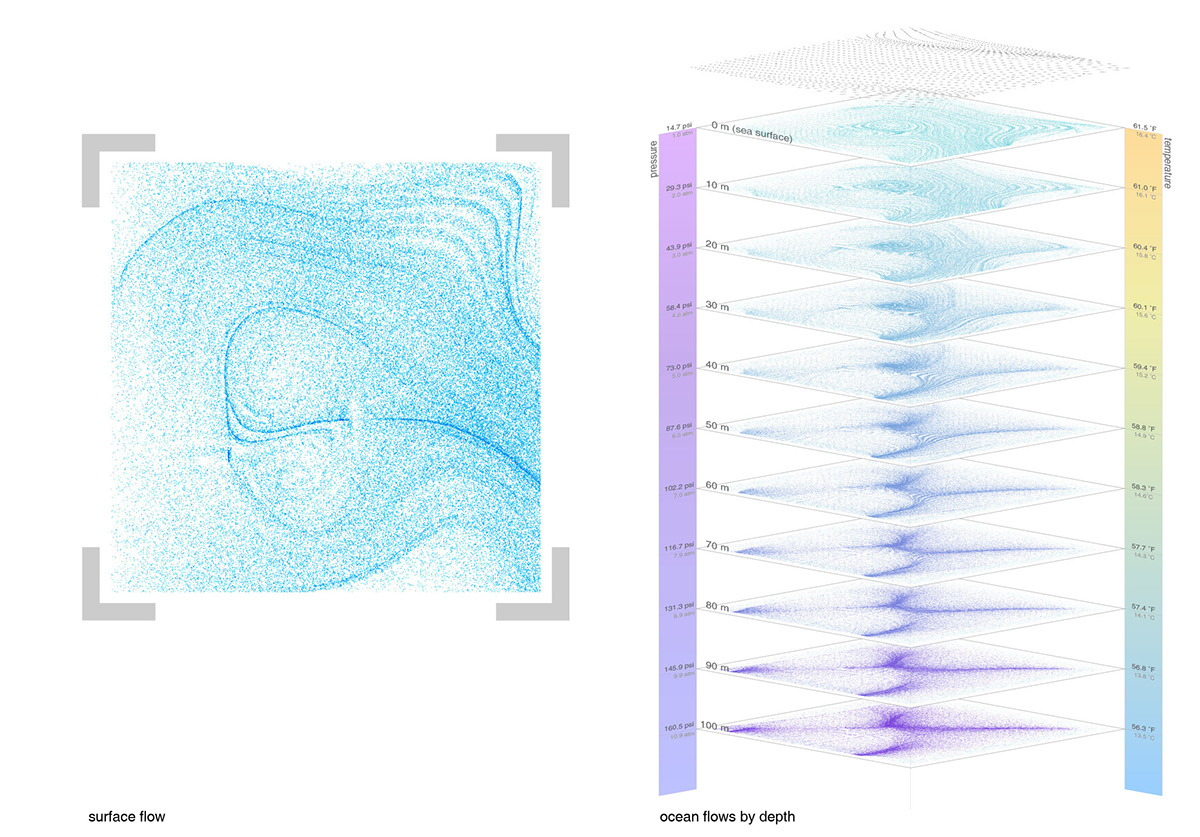
surface flow & ocean flows by depth
video: ocean flows
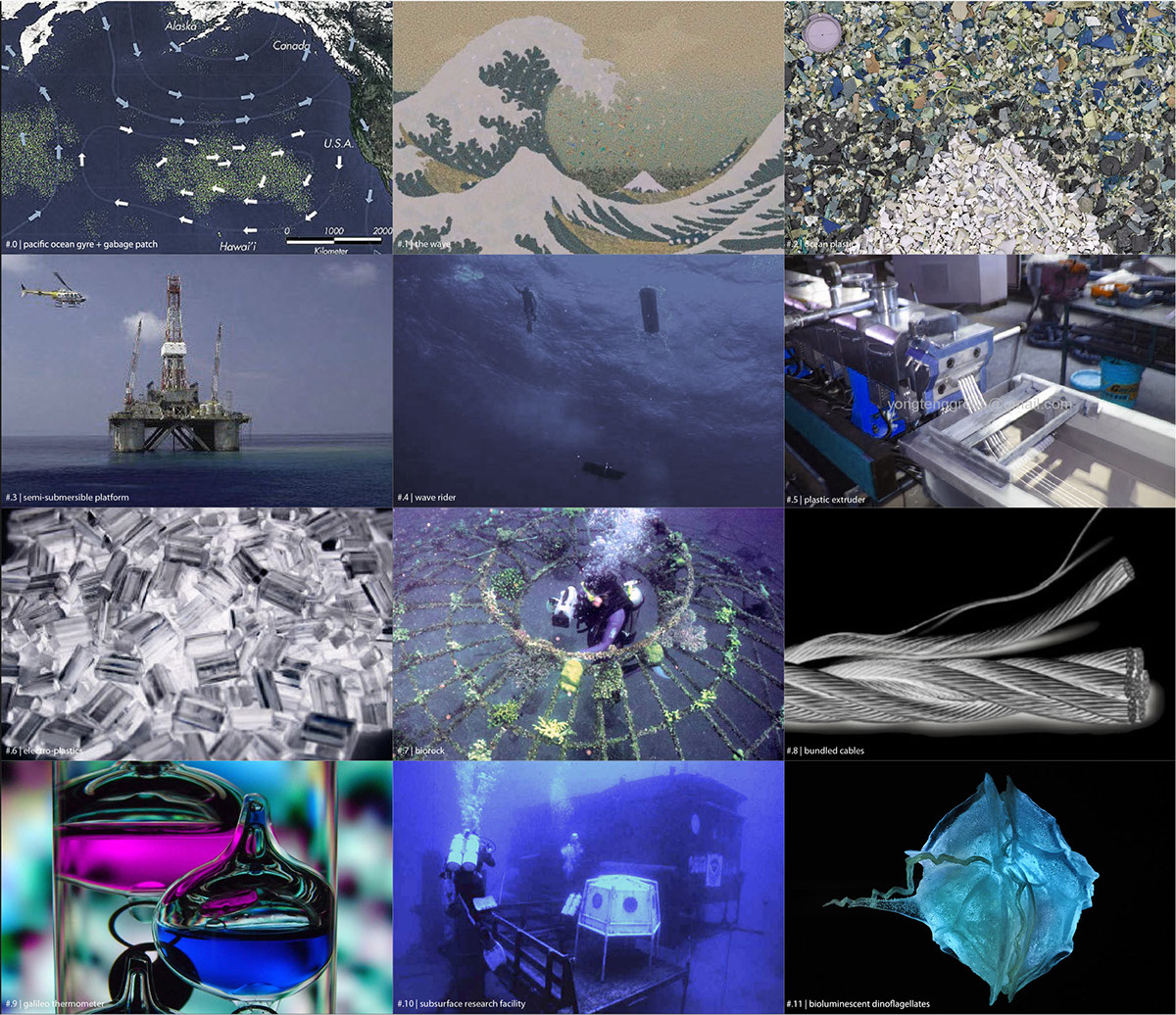
reference: existing technologies
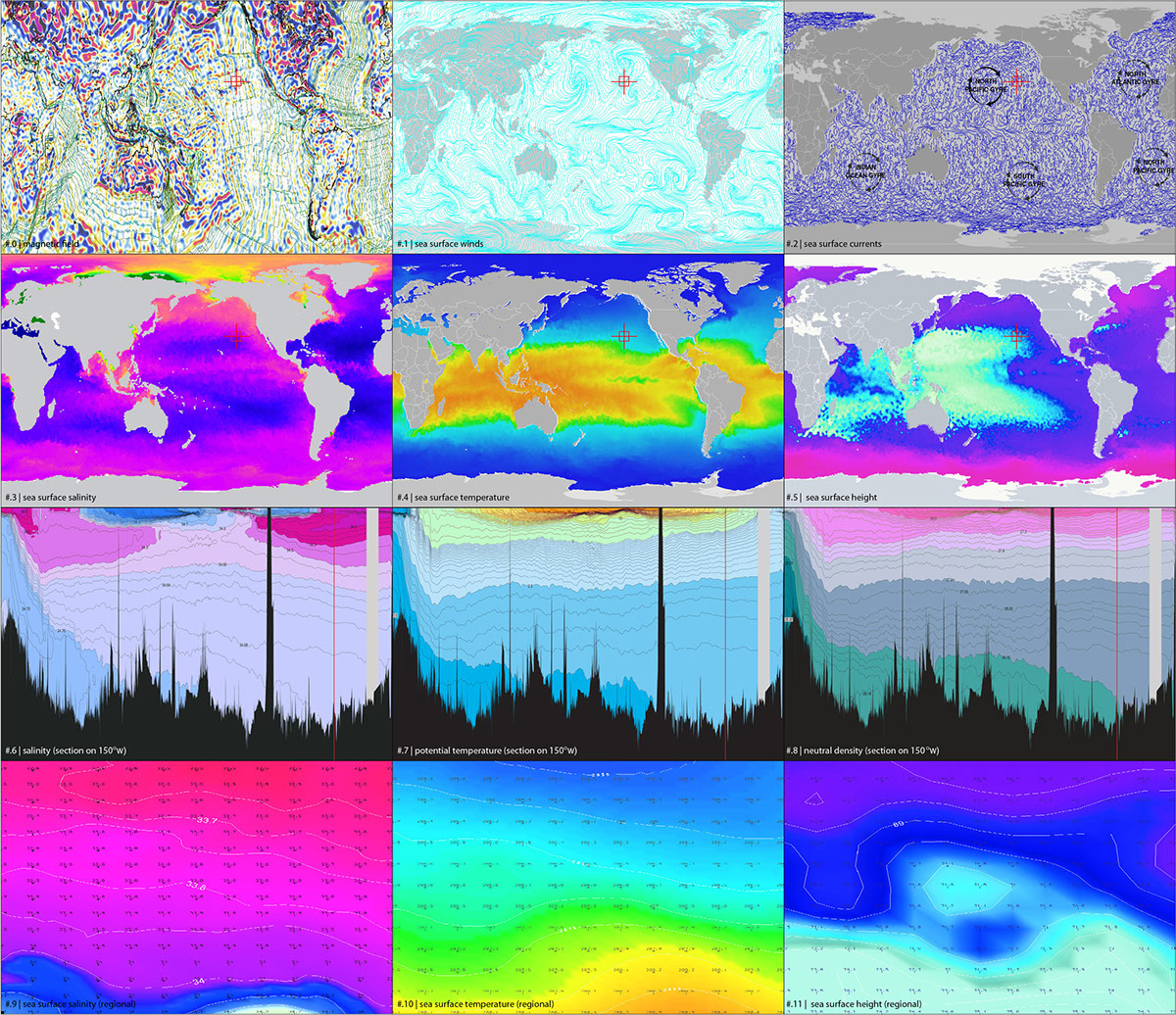
site analysis by factors
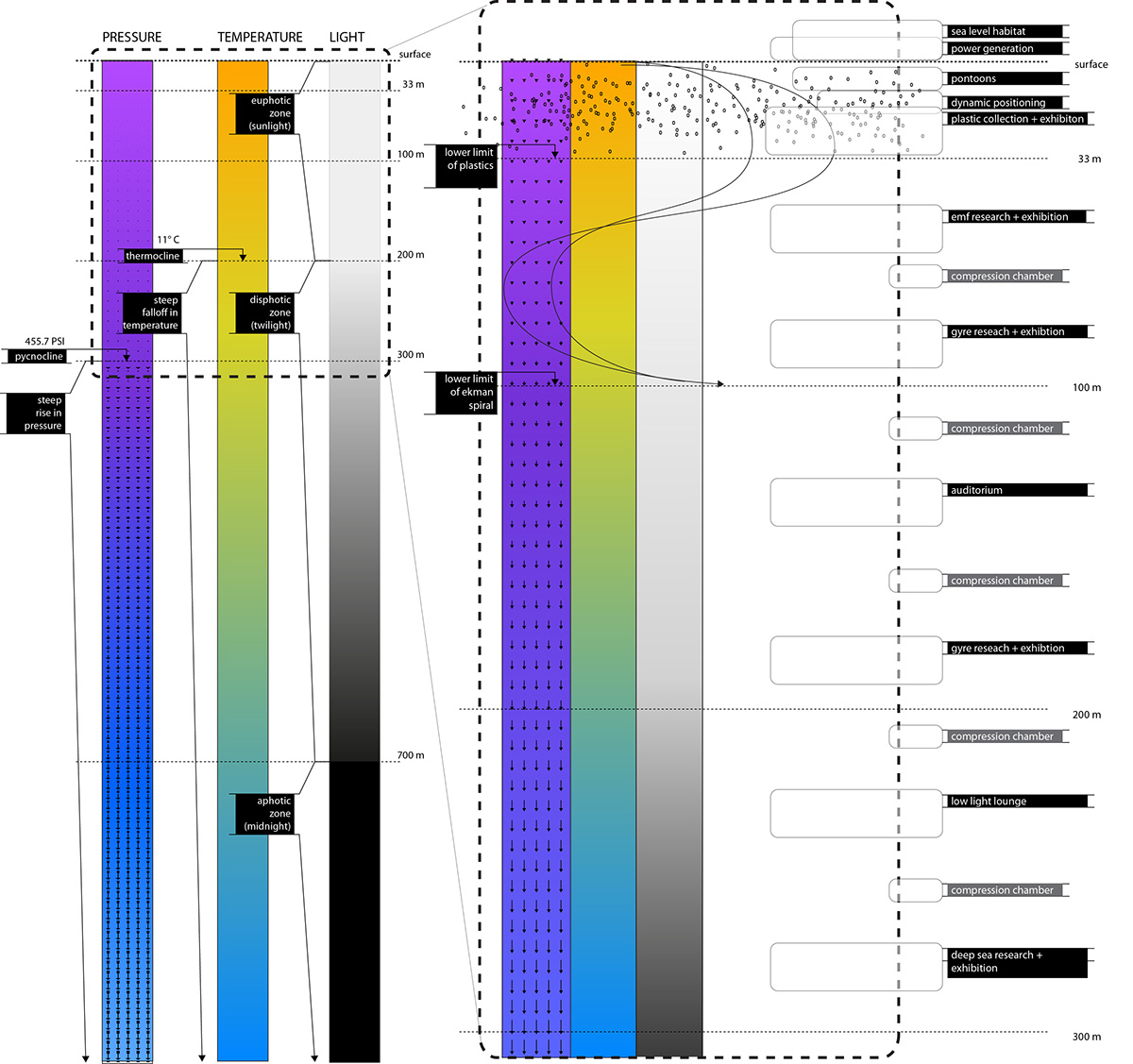
site analysis by depth
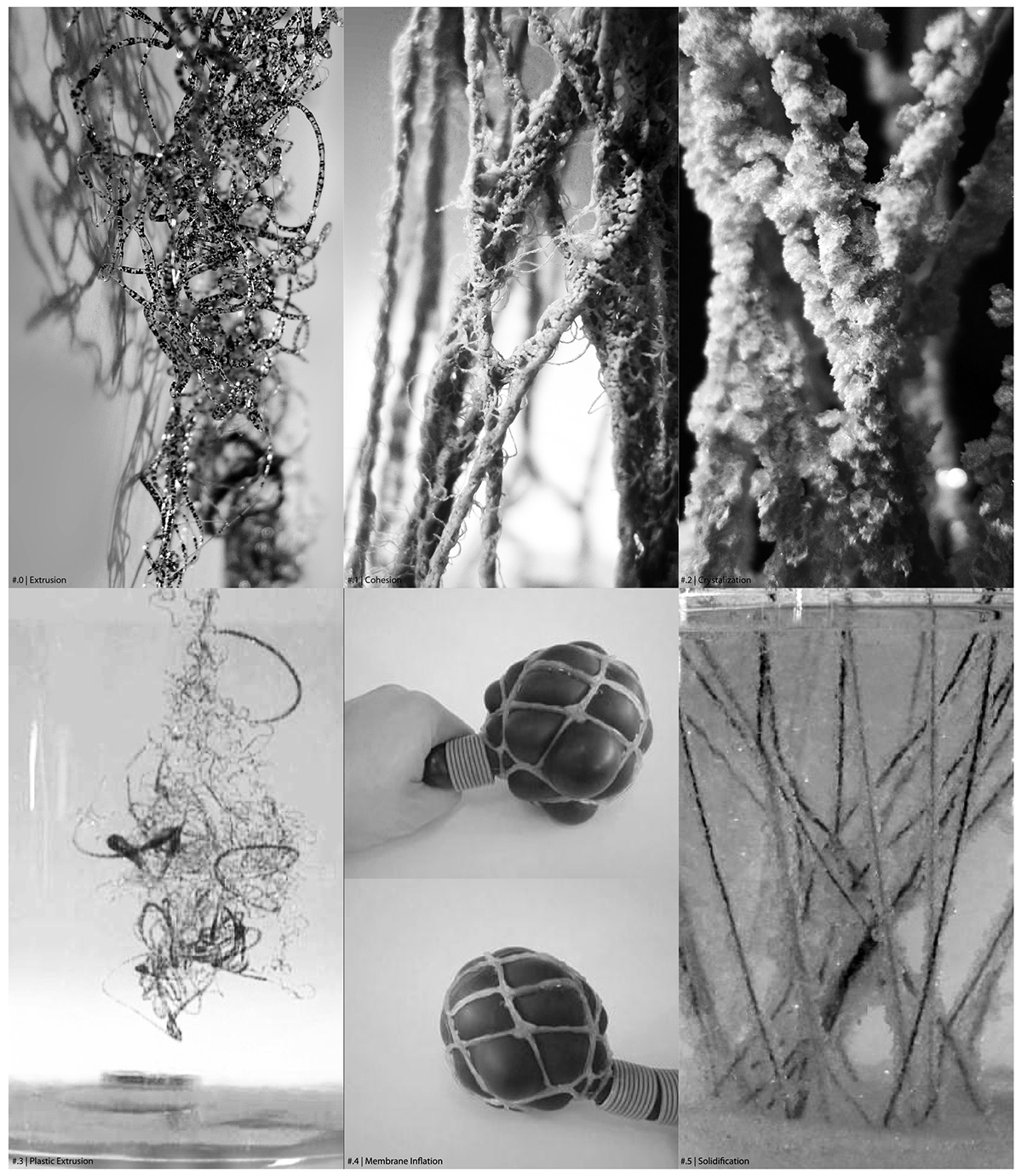
material experiments
video: experiments

simulation of systems
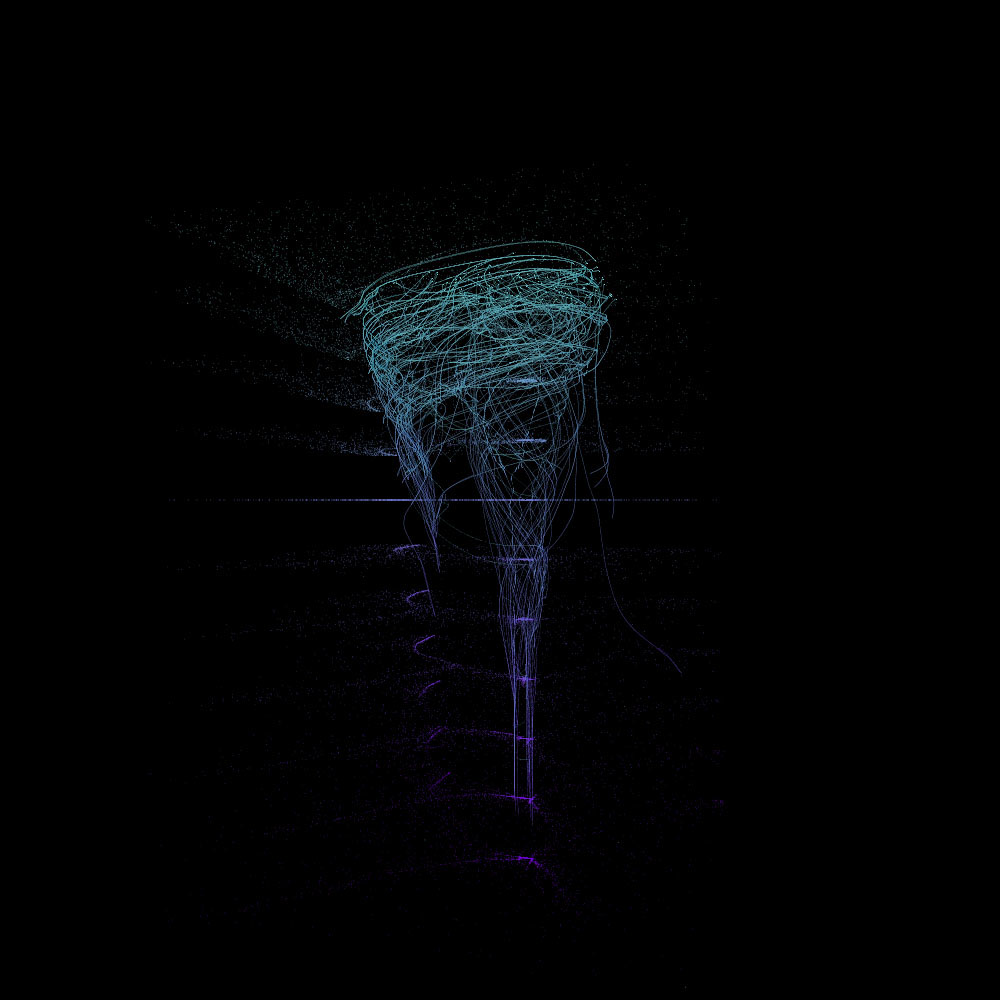
simulation: self-organization of plastic strands structure

simulation: self-organization of plastic strands structure
video: strands formation
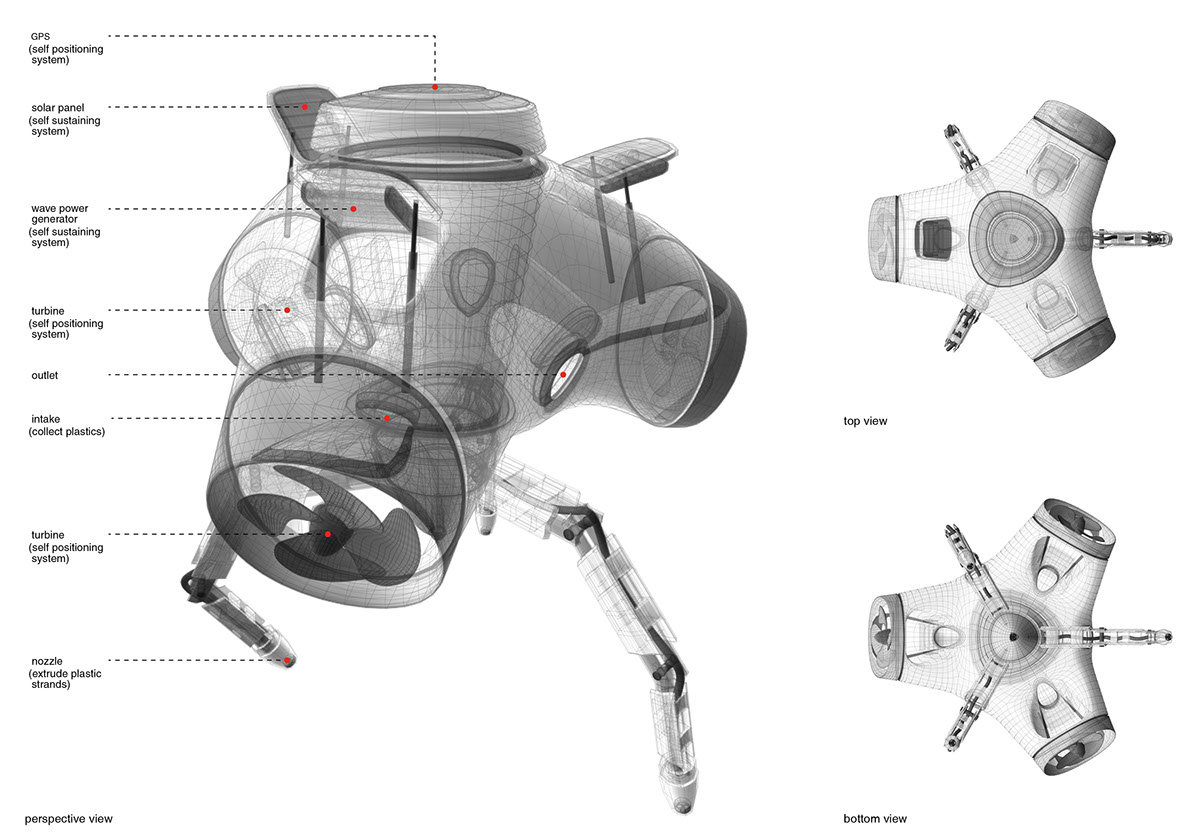
building machine
video: building machine
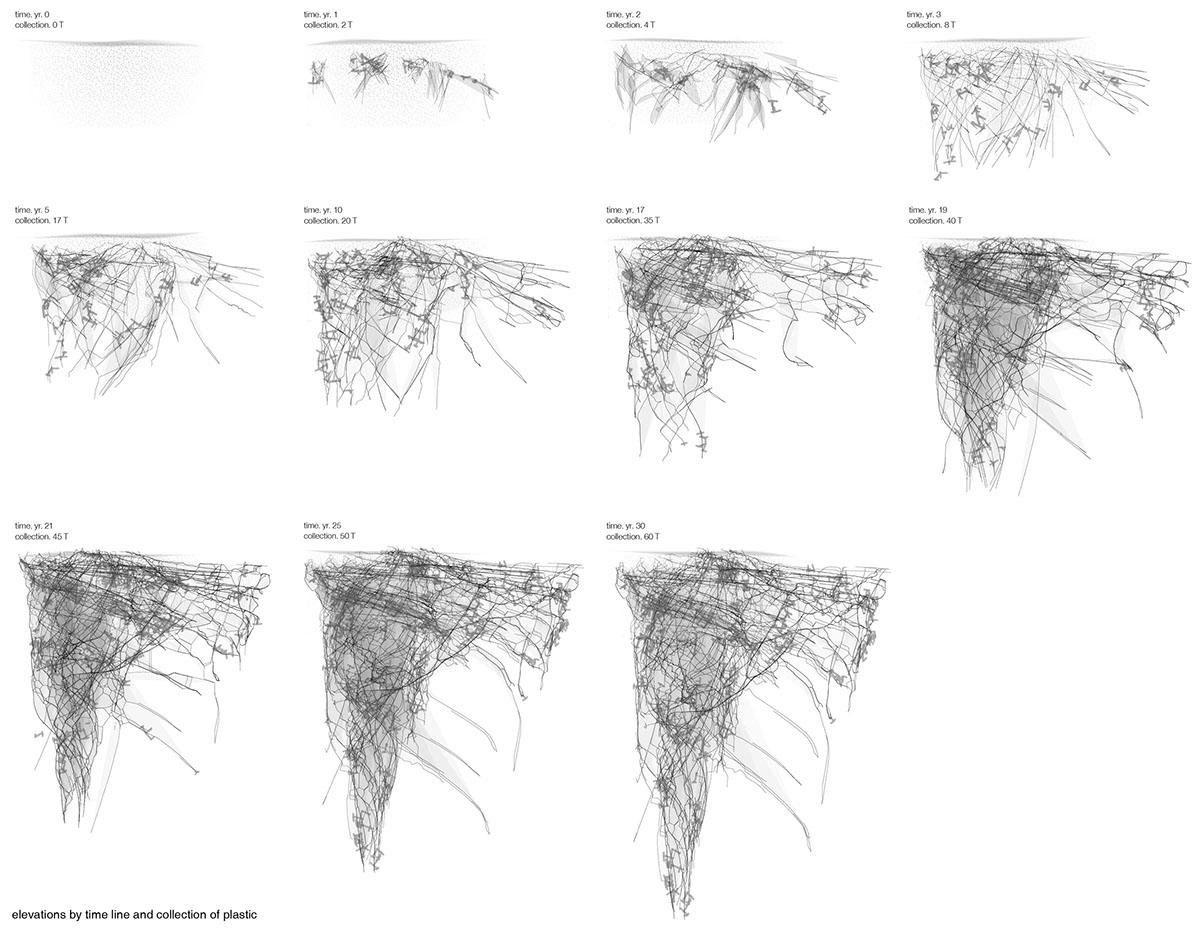
elevations by time line and collection of plastic
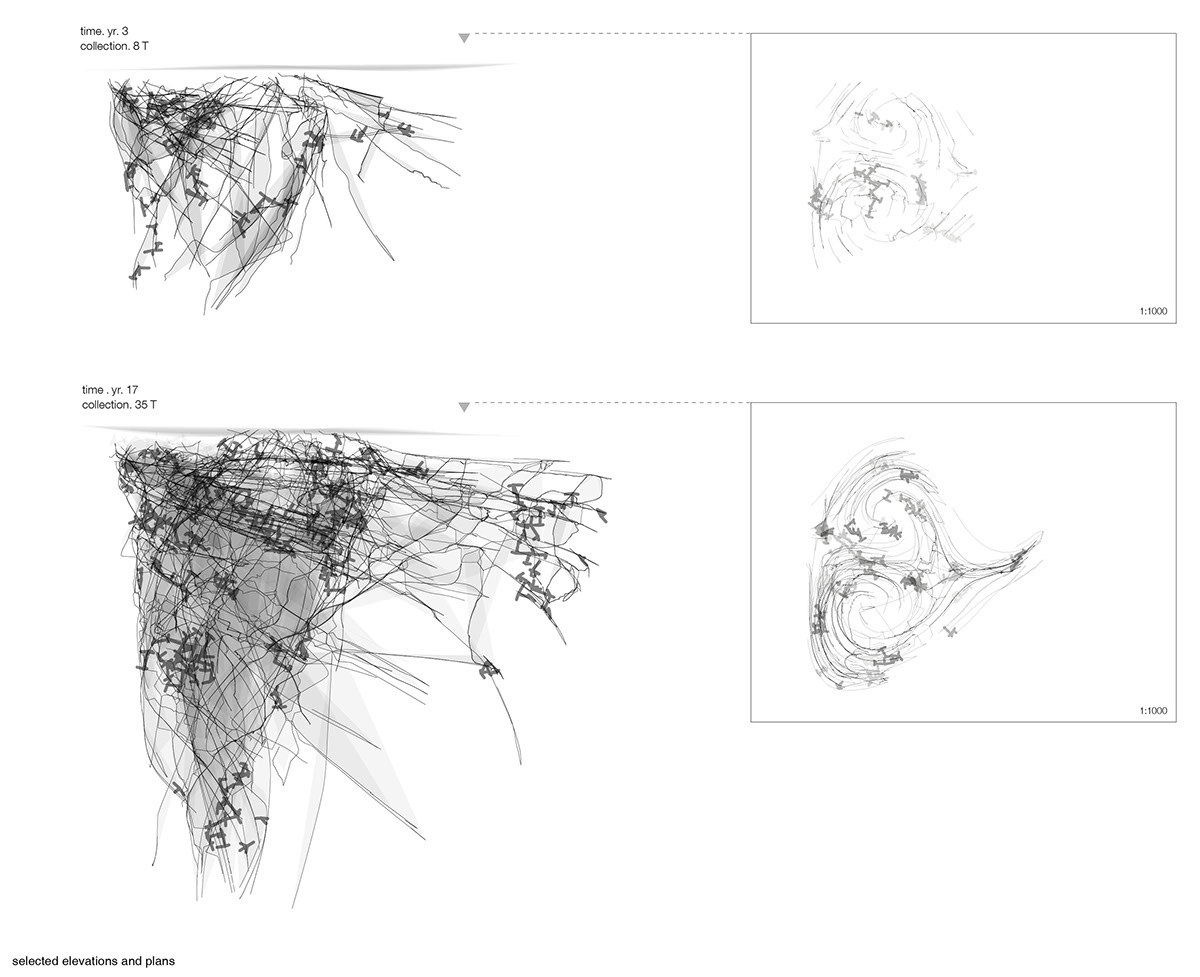


selected elevations and plans by depth

elevation

near ocean surface

section
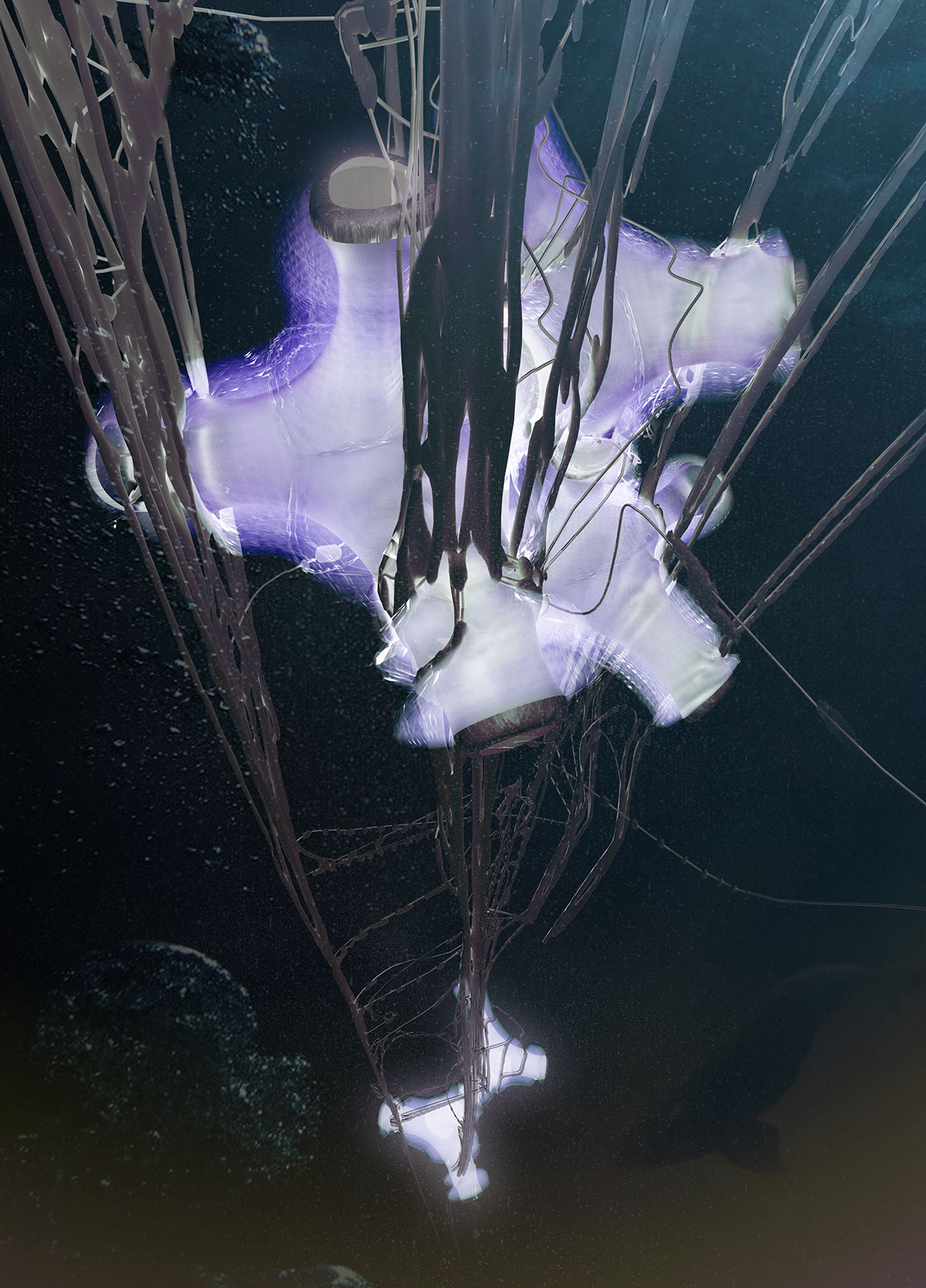
deep sea
Honorable Mention in the eVolo 2013 Skyscraper Competition
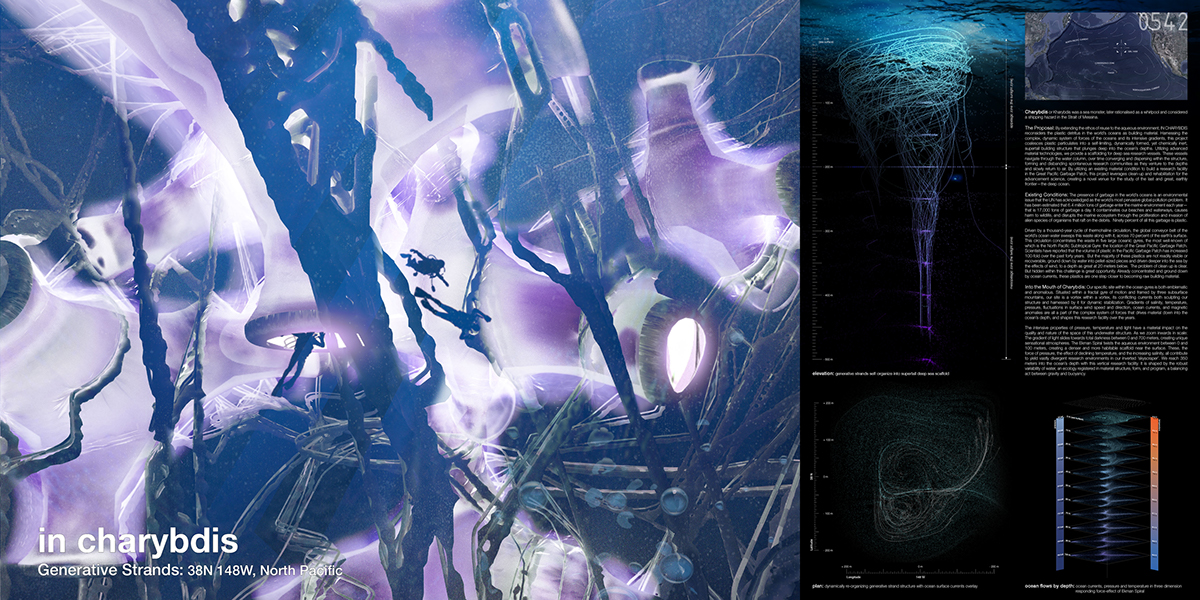

THE PROPOSAL
By extending the ethos of reuse to the aqueous environment, IN CHARYBDIS reconsiders the plastic detritus in the world’s oceans as building material. Harnessing the complex, dynamic system of forces of the oceans and its intensive gradients, this project coalesces plastic particulates into a self-limiting, dynamically formed, yet chemically inert, supertall building structure that plunges deep into the ocean’s depths. Utilizing advanced material technologies, we provide scaffolding for deep sea research vessels. These vessels navigate through the water column, over time converging and dispersing within the structure, forming and disbanding spontaneous research communities as they venture to the depths and slowly return to air. By utilizing an existing material condition to build a research facility in the Great Pacific Garbage Patch, this project leverages clean-up and rehabilitation for the advancement science, creating a novel venue for the study of the last and great, earthly frontier—the deep ocean.
EXISTING CONDITIONS
The presence of garbage in the world’s oceans is an environmental issue that the UN has acknowledged as the world’s most pervasive global pollution problem. It has been estimated that 6.4 million tons of garbage enter the marine environment each year—that is 17,000 tons of garbage a day. It contaminates our beaches and waterways, causes harm to wildlife, and disrupts the marine ecosystem through the proliferation and invasion of alien species of organisms that raft on the debris.[1] Ninety percent of all this garbage is plastic.[2]
Driven by a thousand-year cycle of thermohaline circulation, the global conveyor belt of the world’s ocean water sweeps this waste along with it, across 70 percent of the earth’s surface. This circulation concentrates the waste in five large oceanic gyres, the most well-known of which is the North Pacific Subtropical Gyre: the location of the Great Pacific Garbage Patch. Scientists have reported that the volume of plastic in the Pacific Garbage Patch has increased 100-fold over the past forty years.[3] But the majority of these plastics are not readily visible or recoverable, ground down by water into pellet-sized pieces and driven deeper into the sea by the effects of wind, to a depth as great at 20 meters below.[4] The problem of clean up is clear. But hidden within this challenge is great opportunity. Already concentrated and ground down by ocean currents, these plastics are one step closer to becoming raw building material.
INTO THE MOUTH OF CHARYBDIS
Our specific site within the ocean gyres is both emblematic and anomalous. Situated within a fractal gyre of motion and framed by three subsurface mountains, our site is a vortex within a vortex, its conflicting currents both sculpting our structure and harnessed by it for dynamic stabilization. Gradients of salinity, temperature, pressure, fluctuations in surface wind speed and direction, ocean currents, and magnetic anomalies are all a part of the complex system of forces that drives material down into the ocean’s depth, and shapes this research facility over the years.
The intensive properties of pressure, temperature and light have a material impact on the quality and nature of the space of this underwater structure. As we zoom inwards in scale: The gradient of light slides towards total darkness between 0 and 700 meters, creating unique sensational atmospheres. The Ekman Spiral twists the aqueous environment between 0 and 100 meters, creating a denser and more habitable scaffold near the surface. These, the force of pressure, the effect of declining temperature, and the increasing salinity, all contribute to yield vastly divergent research environments in our inverted ‘skyscraper’. We reach 350 meters into the ocean’s depth with this vertical research facility. It is shaped by the robust variability of water, an ecology registered in material structure, form, and program, a balancing act between gravity and buoyancy.
[1] http://www.unep.org/regionalseas/marinelitter/publications/docs/plastic_ocean_report.pdf
[2] http://science.howstuffworks.com/environmental/conservation/issues/great-pacific-garbage-patch-explained.htm
[3] http://www.sciencedaily.com/releases/2012/05/120508220114.htm
[4] http://www.today.com/id/47206045/ns/today-today_tech/t/plastic-trash-oceans-vastly-underestimated/#.UPd-XvL2-Wg

Elevation: generative strands self-organize into supertall deep sea scaffold

Plan: dynamically re-organizing generative strand structure with ocean surface currents overlay

Ocean Flows by Depth:
ocean currents, pressure and temperature in three dimension responding force-effect of Ekman Spiral

Elevational Time-Line: self-limiting growth based on plastic collection

Building Process
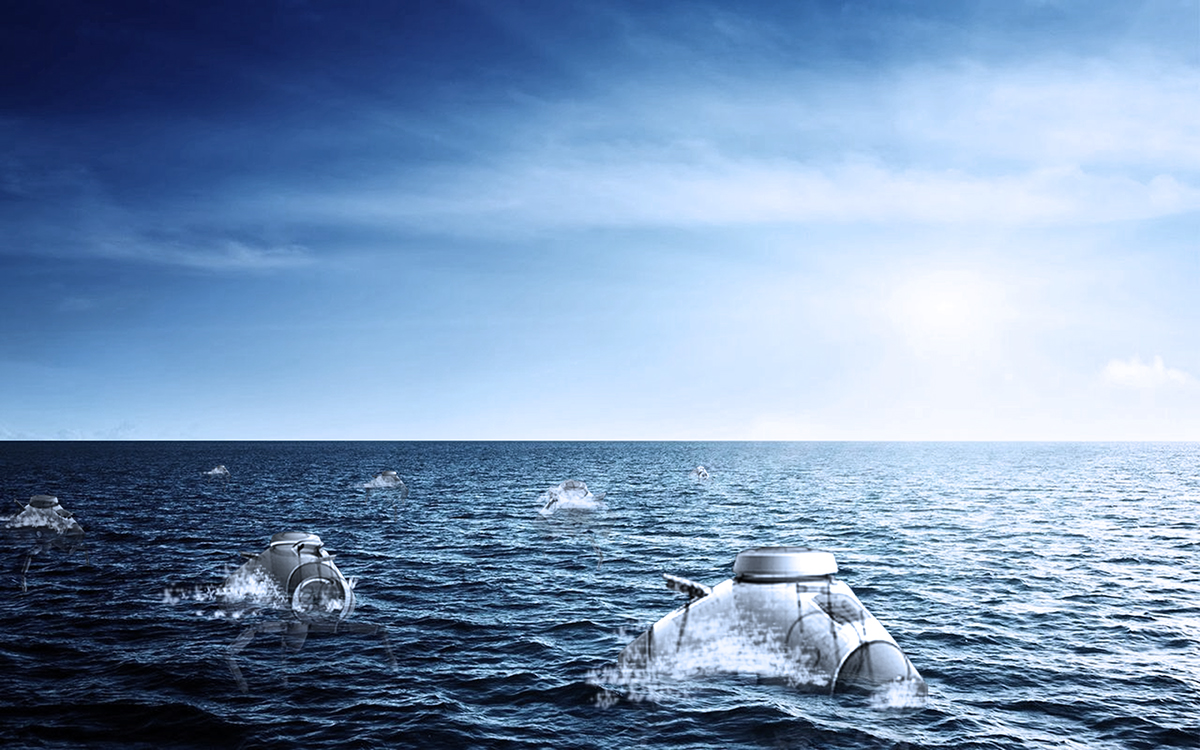
Machines on Ocean Surface

Machine Generating Strands

